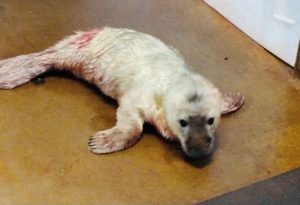CONTACT: Kyle Shepherd
502-238-5331 (Media Cell 502-744-5639)
kyle.shepherd@louisvilleky.gov
Birth Ushers in Good News for a New Year
(Video of Rona and pup bonding and the actual birth at https://youtu.be/niOYBkr_Veg. The red light creates a soothing atmosphere for Rona and the pup and allows staff to monitor in the darkness.)
 LOUISVILLE, Ky. (December 28, 2020) The Louisville Zoo’s 6-year-old gray seal Rona has given birth to her first pup. The Zoo welcomes the pup today at 7:25 a.m. The new pup and mom are doing well.
LOUISVILLE, Ky. (December 28, 2020) The Louisville Zoo’s 6-year-old gray seal Rona has given birth to her first pup. The Zoo welcomes the pup today at 7:25 a.m. The new pup and mom are doing well.
Animal care and animal health care staff had been monitoring Rona overnight for several days, anticipating the birth. Keeper staff report that mom is attentive with her first pup, and the first nursing at noon went well. The pup has been vocal and active indicating a healthy pup.
As Rona is a first-time mom, the Zoo is taking precautions to prevent any disruption of the bonding period with her pup. Rona and pup will remain off exhibit for several weeks while the two bond. Unless necessary, the Animal Health Care team will not perform a neonatal exam until after the pup is weaned. The sex of the pup is currently unknown. Keeper and hospital staff will continue to monitor Rona and her pup; when the sex can be determined visually the Zoo will share those details at that time.
The Zoo will be announcing details for a naming contest sponsored by T-Mobile at a later date.
“The birth went very smoothly, with no complications,” said Associate Veterinarian Dr. Julie Ter Beest. “We’re delighted to see that Rona’s maternal instincts appear to be strong. The pup is vocalizing normally, has nursed, and appears healthy.”
“The Zoo has a successful history of gray seal births in the late 70s and 80s. We are excited to be able to continue that tradition with Rona’s first pup,” said Louisville Zoo Director John Walczak. “Births are always uplifting for the staff, and we look forward to celebrating this pup’s birth with our community.”
Seal pups weigh approximately 30 – 35 lbs. at birth and are born with a soft white coat called lanugo. Weaning occurs after pups nurse for only four weeks, during which time they gain approximately 100 lbs. by nursing on high-fat milk. By the time they are weaned, the lanugo is molted, and the pups assume adult coloration. Seal pups are not agile swimmers until they have molted.
The seal pregnancy is a planned part of the Association of Zoos and Aquariums (AZA) Species Survival Plan (SSP) for gray seals. Breeding plans work to maintain the genetic diversity of managed animal populations.
The Louisville Zoo has a history with this species. Eight seal pups have been born at the Zoo, and when twin seal pups were born in 1979, they were the first twins to be documented in a managed system like a Zoo.
Guests can follow the journey with weekly Seal “Pup-dates” on Sundays sponsored by T-Mobile on the Zoo’s website and Facebook.
ABOUT GRAY SEALS
Gray seals are found in temperate and subarctic coastal waters of the North Atlantic. This species can be distinguished from harbor seals by their long noses, wider set nostrils, and size, which is approximately twice as large as harbor seals. Gray seals primarily eat fish. At the Zoo, squid is a treat. Seals have good senses to help them hunt. Their underwater eyesight and hearing are excellent and they can use their long whiskers, or vibrissae, to touch objects or perceive and analyze water movements. Gray seals can sleep underwater for up to 30 minutes at a time.
***
The Louisville Zoo, a nonprofit organization and state zoo of Kentucky, is dedicated to bettering the bond between people and our planet by providing excellent care for animals, a great experience for visitors, and leadership in scientific research and conservation education. The Zoo is accredited by the Association of Zoos and Aquariums (AZA).
# # #

